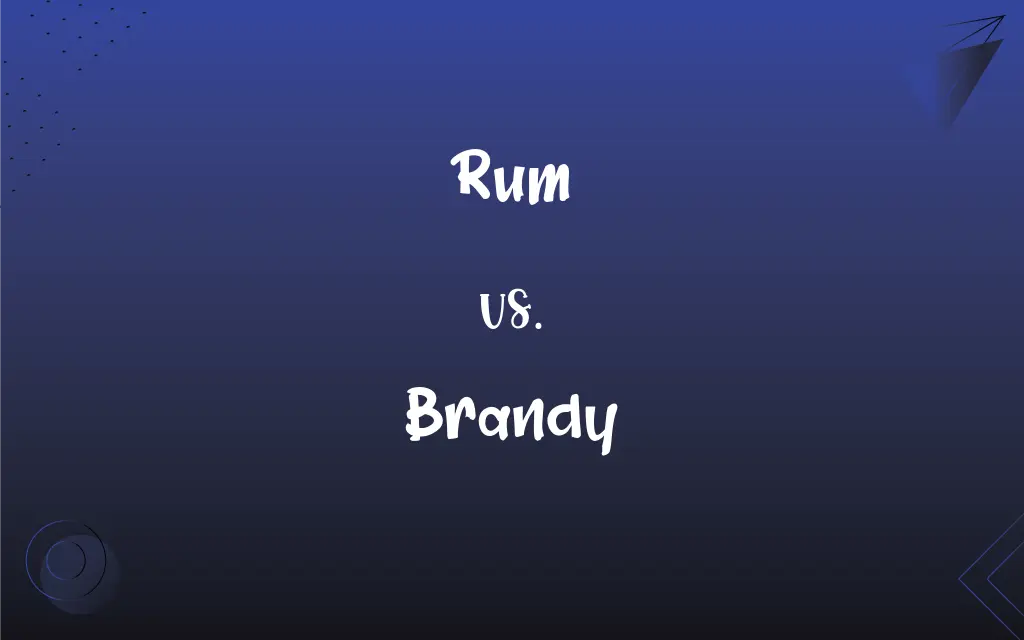Rum vs. Brandy: What's the Difference?
Edited by Aimie Carlson || By Harlon Moss || Updated on October 27, 2023
Rum is distilled from sugarcane byproducts, while brandy is distilled from fermented fruit juice, primarily grapes.

Key Differences
Rum is a spirit known for its association with the Caribbean, being distilled primarily from molasses or sugarcane juice. Brandy, on the other hand, is a distilled spirit made predominantly from fermented fruit juices, with grapes being the most common fruit used.
While rum's flavor profiles often encompass sweet, rich, and caramel-like notes due to its sugarcane origin, brandy offers a varied flavor palette, ranging from fruity and wine-like to woody and complex, depending on its age and the fruit base.
Historically, rum has strong ties with sea voyages, pirates, and the colonial era, especially in the Caribbean and the Americas. Brandy's roots are more closely associated with European regions, particularly France, where it is celebrated as a fine after-dinner drink.
The production of rum usually involves the fermentation of sugarcane juice or molasses, followed by distillation and aging. Brandy's production, on the other hand, starts with fermenting fruit juice, then distilling it, and often aging it in oak barrels to enhance its flavors.
Both rum and brandy can be consumed neat, on the rocks, or as a base in various cocktails. While rum is the primary ingredient in drinks like mojitos and daiquiris, brandy is often savored in classics like the Sidecar or Brandy Alexander.
ADVERTISEMENT
Comparison Chart
Base Ingredient
Sugarcane byproducts (molasses or sugarcane juice)
Fermented fruit juice (primarily grapes)
Flavor Profile
Often sweet, rich, caramel-like
Fruity, wine-like to woody depending on age
Historical Association
Caribbean, sea voyages, pirates
Europe, particularly France
Production Process
Fermentation of sugarcane, distillation, aging
Fermentation of fruit juice, distillation, often aged in oak barrels
Common Cocktails
Mojitos, Daiquiris
Sidecar, Brandy Alexander
ADVERTISEMENT
Rum and Brandy Definitions
Rum
Flavor profiles can be sweet and caramel-like.
The aged rum had a rich, caramel undertone.
Brandy
Grapes are the most common base for brandy.
The grape-based brandy had a distinct wine-like flavor.
Rum
It's a primary ingredient in many cocktails.
She ordered a rum-based mojito.
Brandy
Brandy is distilled from fermented fruit juice.
She poured herself a glass of fine brandy.
Rum
Rums can be light, golden, or dark.
The golden rum was smooth and flavorful.
Brandy
It can be aged in wooden casks for enhanced flavors.
Aged brandy is often smoother and more refined.
Rum
Rum is an alcoholic spirit distilled from sugarcane.
He savored a glass of dark rum after dinner.
Brandy
Known for its rich and varied flavor profiles.
The apple brandy had a delightful fruity note.
Rum
It often originates from the Caribbean.
The best rum he ever tasted was from Jamaica.
Brandy
Often consumed as an after-dinner drink.
He preferred brandy as his digestif.
Rum
An alcoholic liquor distilled from fermented molasses or sugarcane.
Brandy
An alcoholic liquor distilled from wine or fermented fruit juice.
FAQs
Which spirit is older, rum or brandy?
Both have ancient origins, but brandy's documented history predates rum's.
Is cognac a type of brandy?
Yes, cognac is a type of brandy made in the Cognac region of France.
Are there rums that aren't made in the Caribbean?
Yes, rum is made globally, but the Caribbean is historically significant.
Do all rums taste similar?
No, flavor profiles vary widely based on production and origin.
Is rum made from fruit like brandy?
No, rum is distilled from sugarcane byproducts, while brandy is from fermented fruit juice.
Which has a sweeter taste, rum or brandy?
Rum often has a sweeter profile, while brandy's sweetness varies based on the fruit.
Can rum be smoky in flavor?
Yes, some rums, especially those using specific production methods, can be smoky.
How should they be stored?
In a cool, dark place. They don't continue to age in the bottle.
Is rum always sweet?
Most rums have a sweet profile, but there are variations.
Are there health benefits to either drink?
Moderate consumption may offer benefits, but excessive drinking has risks.
Is brandy popular in cooking?
Yes, brandy is often used in sauces, desserts, and flambés.
Can brandy be made from fruits other than grapes?
Yes, there are apple, pear, and other fruit brandies.
What’s the difference between brandy and cognac?
All cognac is brandy, but only brandy made in the Cognac region of France is cognac.
Which is more popular globally?
Both are popular, but rum has a broader global reach, while brandy is particularly popular in Europe.
Why is some rum dark and some light?
The color is influenced by aging and added caramel.
Is brandy a type of wine?
No, but it's distilled from fermented fruit juice, often grapes.
Why is rum associated with pirates?
Rum was popular in sea voyages and the Caribbean, where piracy was rampant.
How are the aging processes different?
Both can be aged in barrels, impacting flavor, but specifics vary by type and region.
Which has higher alcohol content?
Both vary, but typically they range from 35-50% alcohol by volume.
How are rum and brandy best enjoyed?
Both can be sipped neat, with ice, or in cocktails.
About Author
Written by
Harlon MossHarlon is a seasoned quality moderator and accomplished content writer for Difference Wiki. An alumnus of the prestigious University of California, he earned his degree in Computer Science. Leveraging his academic background, Harlon brings a meticulous and informed perspective to his work, ensuring content accuracy and excellence.
Edited by
Aimie CarlsonAimie Carlson, holding a master's degree in English literature, is a fervent English language enthusiast. She lends her writing talents to Difference Wiki, a prominent website that specializes in comparisons, offering readers insightful analyses that both captivate and inform.































































